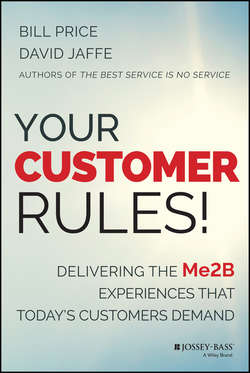Читать книгу Your Customer Rules! - Bill Price - Страница 14
На сайте Литреса книга снята с продажи.
Chapter Two
You Know Me, You Remember Me
You Never Ask What You Already Know
ОглавлениеIf an organization has succeeded with “know me and remember me,” then it already has a lot of information stored about the customer. Given that, it should use this information to save the customer effort, never asking anyone to input or repeat data they've given in the past.
Retaining memory of partially completed processes is also valuable. Smart websites let companies retain information from half-completed applications even though the user may not yet be a customer. Leaders in this space extend this across channels so that forms are pre-filled at the counter or in any other sales channel when the customer does decide to make a purchase.
Bad Stories: Putting the Customer to Work
One burdensome failure about “Never ask what you already know” is found in U.S. hospitals and doctor's offices that persist in asking patients to complete a health history form, again, every time they show up for an office appointment. Instead of asking for any changes from the last visit, which might have been only two months ago, the original five-page form is presented.
Similarly, information a customer has supplied to a business in an interactive voice response system (IVR), on a web form, or anywhere else should carry through the process. We've all experienced giving information to an IVR only to have to repeat it two minutes later to a live agent. (At Bill's bank, where he's been a customer for fifteen years, his complaints about this experience with contact center agents always produce the same response, “We tell the IT group but they don't listen to us!”)
Poorly integrated computer systems are often to blame here. When customers are transferred across a company and switch systems, they may have already identified themselves in system A, but the agent they are talking to in a new department is on system B. It's difficult to get this level of integration, but that doesn't excuse the effort it creates for customers.
Of course, companies do have ways to confirm customer identity without excessive questioning, but the lowest-effort solutions use expensive new technologies such as voice biometrics (recognizing your voice) and retina scanning. Even if such systems aren't practical in a given instance, however, companies can make the ID process as painless as possible.
Landline telephone companies have good forms of identity in their systems but seem to ignore them. They often ask at the outset of a customer call, “What is your account number?” eliciting a “huh?” in response. In many cases the customer's phone number is their account number. If a customer uses that number to call the telephone company, technologies like ANI or CLI can associate the customer's number with a database, and use it to ID the customer. Still, these companies often require further proof questions, even for calls when sensitive data doesn't come into play. It would be a lot easier for both parties if the agent simply asked, “I see that you're using the phone number associated with an account we have, is this Joe Smith?”
Good Stories: Personalized Experiences
Me2B Leaders are simplifying customers' lives by reusing data intelligently and consistently. American Express, for example, recently updated its card payment sign-in page, which now pre-populates the data fields for user name and password, thus moving members more quickly into their account. This is a great example of using browser cookies to avoid asking the member for information already on hand. The company prides itself that “Membership Matters,” and even in just this one small change, it shows.
Amazon CEO Jeff Bezos has long spoken of his vision to have Amazon deliver personalized pages for each customer, and the company is well on its way. When someone visits Amazon, the company's home page immediately appears with four to seven personalized features based on its knowledge of that customer's shopping history. That data enables Amazon to display recommendations particular to this customer, along with account details, video streaming service, wish list, and previously viewed items.
Конец ознакомительного фрагмента. Купить книгу
